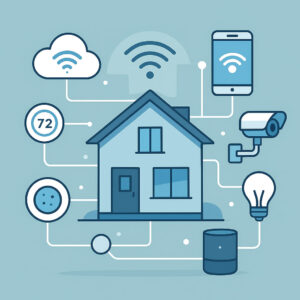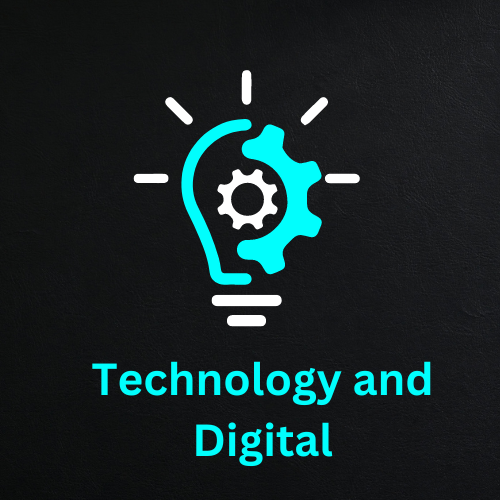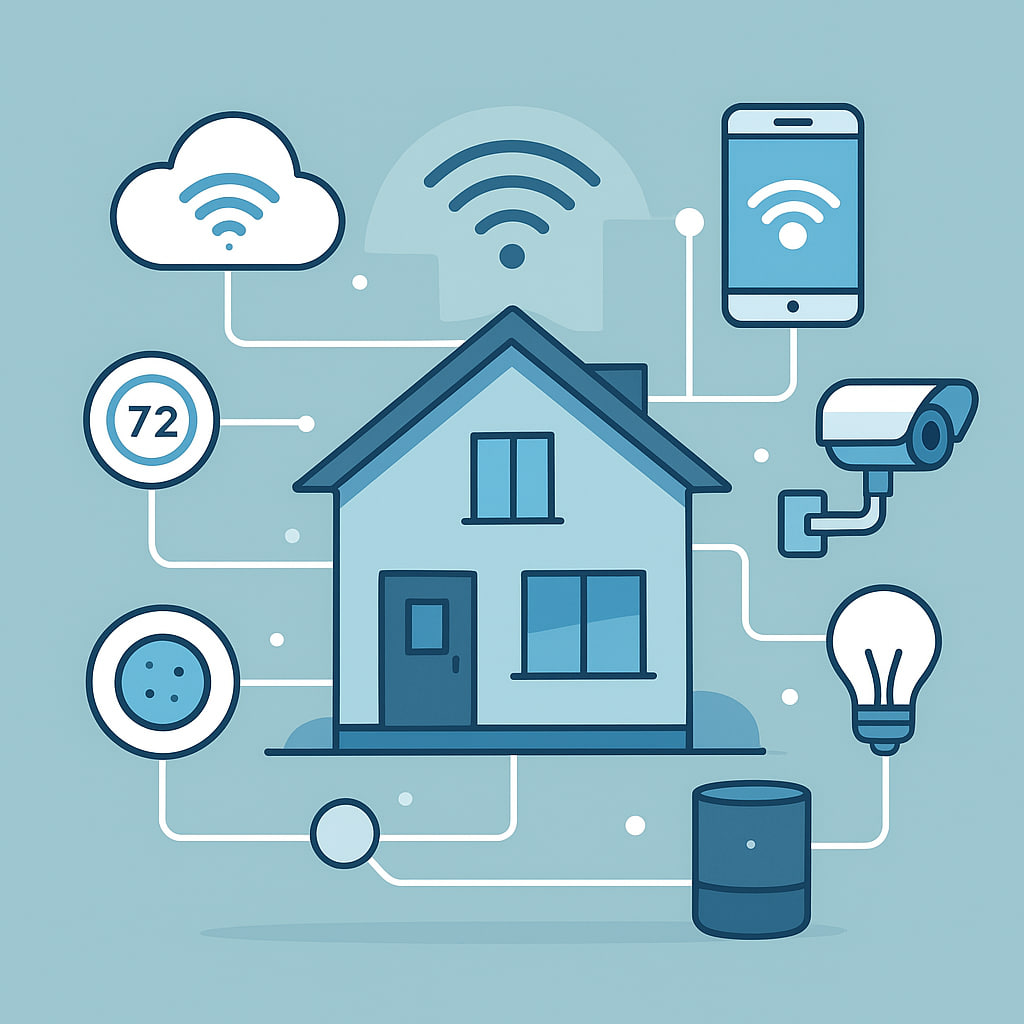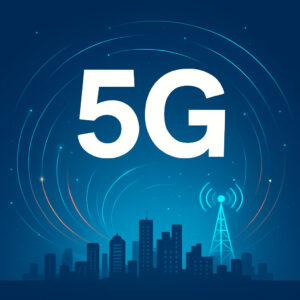The Internet of Things (IoT) in Smart Homes: Redefining the Art of Living

In a world where walls listen, lights think, and appliances respond, the Internet of Things (IoT) is quietly transforming ordinary homes into intelligent sanctuaries. Once a futuristic dream, smart homes have now stepped into reality, breathing life into our living spaces and reshaping how comfort, security, and convenience are defined in 2025.
Every corner of the modern home hums with connectivity — lights that adjust to mood, thermostats that learn from behavior, and refrigerators that whisper reminders. The IoT revolution has not only connected devices but also emotions, weaving technology seamlessly into daily routines. This is not merely a tale of machines; it’s a story of harmony between human instinct and digital intelligence.
Understanding IoT in Smart Homes
The Internet of Things is more than a buzzword — it is the nervous system of modern living. Simply put, IoT refers to the network of physical devices embedded with sensors, software, and connectivity that allow them to collect and exchange data. In smart homes, these devices work together to create a responsive environment that learns, adapts, and evolves with the residents’ needs.
From smart thermostats that predict temperature preferences to AI-powered voice assistants like Alexa and Google Home that respond to natural commands, IoT technology forms the invisible thread tying it all together. Imagine returning home after a long day, and your lights gently brighten, the room temperature adjusts to your comfort, and your favorite music softly begins to play — all without pressing a single button.
Key Components of a Smart Home Ecosystem
- Smart Sensors: Detect motion, temperature, humidity, and more, allowing for precise environmental control.
- Connected Appliances: From washing machines to air purifiers, IoT appliances simplify household chores.
- Smart Lighting: Adaptive lighting systems that adjust brightness and color based on mood or time of day.
- Voice Assistants: Act as the central hub for managing connected devices hands-free.
- Security Systems: Smart cameras and locks that offer real-time surveillance and control from anywhere in the world.
The Emotional Pulse of Smart Living
There is something deeply human about technology that listens and learns. Smart homes, powered by IoT, go beyond automation — they anticipate needs. They reflect lifestyles. They respond with empathy coded into circuits.
When a light dims as bedtime nears or a coffee machine awakens with the sunrise, it feels almost poetic. Technology here is not intrusive; it is intuitive. It understands silence, mood, and habit. In many ways, IoT in smart homes is not just about convenience — it’s about crafting an emotional rhythm between the human spirit and digital awareness.
But the heart of this evolution lies in balance — ensuring that smart homes serve as companions, not controllers. The beauty of IoT is in its subtlety, offering aid without overshadowing autonomy.
The Benefits: Convenience Meets Conscious Living
The benefits of IoT-driven smart homes stretch far beyond comfort. They touch sustainability, safety, and health — the pillars of mindful living. Let’s explore the most remarkable advantages.
1. Energy Efficiency and Sustainability
Smart thermostats and energy monitors help households reduce waste. By analyzing patterns and adjusting systems automatically, IoT minimizes unnecessary energy use. For instance, motion sensors turn off unused lights, and smart plugs cut power to idle devices. In an age of environmental awareness, IoT homes are not only intelligent but also responsible.
2. Enhanced Security and Peace of Mind
IoT-enabled security systems bring reassurance. Cameras with live feeds, door sensors, and AI-based motion detection allow homeowners to monitor their space remotely. Smart locks add an extra layer of control — doors can be locked or opened with a single voice command or through an app. In moments of uncertainty, knowing your home watches over you is priceless.
3. Health and Wellness Integration
Well-being now begins at home. Air quality sensors detect pollutants and adjust purifiers. Smart beds monitor sleep patterns. Even mirrors equipped with health analytics can track skincare or fitness goals. IoT empowers individuals to take charge of their wellness effortlessly, making every breath and heartbeat a part of digital care.
4. Unmatched Convenience
From remotely preheating ovens to receiving a phone alert when laundry is done, IoT transforms mundane tasks into effortless actions. The seamless interaction among devices saves time and mental load — giving homeowners the gift of simplicity.
The Challenges: When Connectivity Becomes a Double-Edged Sword
Yet, with all its brilliance, IoT is not without shadows. Every connected device opens a door — and not all doors lead to safety. Security vulnerabilities and data privacy concerns are among the most pressing challenges in the IoT ecosystem.
Hackers can exploit weak links to gain access to networks, while poorly configured devices may leak sensitive data. As convenience expands, so does the responsibility of ensuring digital protection. Manufacturers are now prioritizing encrypted communication and frequent updates, while users are encouraged to use strong passwords and secure Wi-Fi networks.
Another concern is dependency. With automation managing daily tasks, there’s a risk of over-reliance. A simple network failure can disrupt routines. Thus, balance becomes essential — technology should empower, not dominate.
The Future of IoT in Smart Homes (2025 and Beyond)
The evolution of IoT is accelerating. By 2025, over 75 billion connected devices are expected to be active globally. Smart homes are evolving into adaptive ecosystems, capable of predicting not only needs but emotions.
Emerging trends like AI integration, edge computing, and 5G connectivity are amplifying IoT’s power. Edge computing, in particular, allows devices to process data locally, ensuring faster responses and improved privacy. Meanwhile, AI brings personalization to a new height — devices will soon understand context and intent, not just commands.
Imagine walls that monitor air composition, mirrors that adjust lighting based on skin tone, or kitchens that suggest recipes based on dietary goals. The smart home of tomorrow will not just connect devices — it will connect lives, habits, and hearts.
Practical Tips for Building a Smart Home
- Start Small: Begin with one or two smart devices — such as lighting or a thermostat — to understand integration and control.
- Choose Compatible Devices: Select products that work well within the same ecosystem, like Google Home or Alexa.
- Prioritize Security: Use strong, unique passwords and keep device firmware updated regularly.
- Invest in a Strong Network: A reliable Wi-Fi system is the backbone of all IoT operations.
- Monitor Usage: Track data and adjust settings to enhance energy efficiency and privacy.
Conclusion: A New Kind of Home, A New Kind of Humanity
The Internet of Things in smart homes represents a quiet revolution — not loud, not forced, but deeply transformative. It’s the fusion of emotion and innovation, where technology listens and responds like a trusted companion. Homes have evolved from shelters into sentient beings — aware, adaptive, and comforting.
As technology continues to evolve, the essence of home remains the same: a space of belonging. IoT simply amplifies that feeling — making every corner warmer, safer, and more attuned to life itself.
What about you? Would you welcome a home that understands you, or does the thought of machines knowing too much feel unsettling? Share your thoughts in the comments and join the conversation about the future of living.




